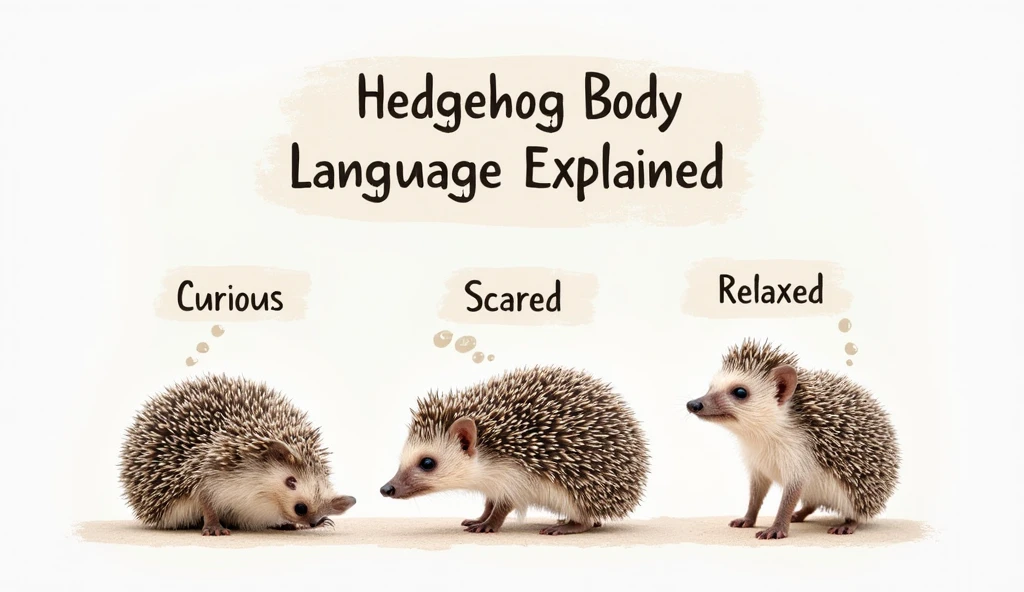What Your Hedgehog Is Really Trying to Tell You
Hedgehogs might not bark, purr, or wag their tails like dogs or cats, but they still communicate in their own special way. By learning to understand your hedgehog’s body language and behavior, you’ll be able to respond to their needs, comfort them when they’re nervous, and build a better bond.
In this article, you’ll learn how to read common hedgehog body signals so you can confidently understand your spiky friend.

Why Body Language Matters
Hedgehogs are solitary and quiet animals, and because they don’t vocalize often, their body language becomes the most important way they express:
- Comfort
- Fear or stress
- Curiosity
- Illness
- Trust
Learning to “read” your hedgehog helps you keep them happy, healthy, and safe.
1. 🌀 Curling into a Tight Ball
What it means: Fear, stress, or feeling threatened.
When a hedgehog curls up and shows its spines, it’s trying to protect itself. This is a natural defense mechanism.
When It’s Normal:
- You just woke them up suddenly.
- They’re in a new environment.
- You’re new to them.
What to Do:
- Speak softly and avoid sudden movements.
- Let them sniff you and approach at their own pace.
- Be patient—it can take time to build trust.
2. 🐾 Uncurling and Exploring
What it means: Relaxed, curious, and comfortable.
When your hedgehog uncurls and starts sniffing around or walking on you, they feel safe and confident.
Good Signs:
- Walking with ease
- Sniffing, licking, or climbing on you
- Using their wheel or exploring new toys
This is the best time to handle and bond with them!
3. 🐽 Sniffing, Licking, and Taste-Testing
What it means: Curiosity or preparing to “self-anoint.”
Hedgehogs explore the world through scent. If they find a new smell (like your soap or a fabric), they may lick it and then start twisting into weird positions to spread foamy saliva on themselves—this is called self-anointing.
Is It Bad?
Nope! It looks strange, but it’s completely normal behavior—usually triggered by new or strong smells.
4. 😠 Hissing, Puffing, or Clicking
What it means: Annoyed, scared, or feeling unsafe.
Hedgehogs make these sounds when they’re unhappy or defensive. It often happens during:
- Sudden handling
- New surroundings
- Loud noises
- Strong smells
What to Do:
- Give them space and let them calm down.
- Use gentle handling techniques.
- Avoid overwhelming them with too much at once.
5. 😴 Sleeping Soundly and Curled Loosely
What it means: Feeling safe and at ease.
A hedgehog that’s loosely curled or sprawled out in their sleeping pouch is comfortable and stress-free.
Good Signs:
- Breathing is calm and steady
- They don’t startle when you walk by
- They stay asleep even if there’s soft noise
This is the goal—a hedgehog that trusts its space and owner.
6. 🐾 Wobbling, Shaking, or Moving Strangely
What it might mean: Illness or stress.
If your hedgehog is off balance, weak, or walking abnormally, this could be a sign of:
- Cold body temperature
- Wobbly Hedgehog Syndrome (WHS)
- Injury or neurological issue
What to Do:
- Check the cage temperature (should be 72–80°F / 22–27°C)
- Handle gently and contact an exotic vet immediately
Don’t ignore strange or sudden changes in body movement.
7. 🚫 Freezing in Place
What it means: Trying to assess danger or stay hidden.
If your hedgehog stops moving suddenly and stays still, they might be scared or unsure. It’s common if:
- You reach into the cage suddenly
- There’s a loud noise
- A new scent is nearby
What to Do:
- Pause and let them assess you
- Speak gently and move slowly
- Avoid startling them again
8. 💩 Pooping When Picked Up
What it means: Stress or nerves—especially in baby hedgehogs.
Hedgehogs often poop when they’re nervous. This is normal during early handling stages or after waking up.
What to Do:
- Don’t panic—it’s common!
- Handle them over a towel or easy-to-clean surface
- With regular bonding, this usually stops
Quick Reference: Common Hedgehog Behaviors
| Behavior | Meaning | What You Should Do |
|---|---|---|
| Curling into a ball | Fear or stress | Be patient and calm |
| Uncurling and sniffing | Relaxed and curious | Good time to interact |
| Hissing or puffing | Defensive | Give space and avoid pressure |
| Self-anointing | New scent reaction | Normal behavior |
| Wobbling or shaking | Possible illness | Call a vet |
| Freezing in place | Cautious or scared | Slow down, give time |
| Pooping during handling | Nervous | Keep calm and be consistent |
Final Thoughts
Understanding your hedgehog’s body language takes time, but it’s one of the best ways to build trust and ensure their well-being. Each hedgehog has their own personality, but with patience and daily observation, you’ll learn their signals and moods quickly.
Remember: Respect their space, handle gently, and always listen to what their body is telling you.

